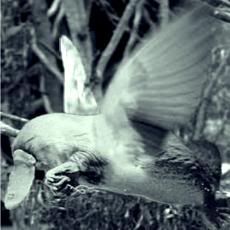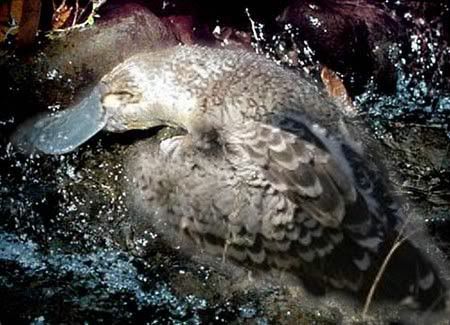|
Platypus vulturis vulgaris Kane/Hoelzel (The Vultipus) Created by: Kane and Hoelzel, in the Genomex laboratories, November 2004 [Additional research by R. Steyn]
For millennia, the vultipus has enjoyed a life in legend and literature, as a unique symbol of tenacity, adaptability, and persistence. Now, the creators happily wish to announce that grace to our joined intellectual excellence, our unparalleled spiritual strength and to our unsurpassed steadiness in moral matters, for the first time in the history of mankind this symbol has been bred living and existing, and by the help of our giftedness in the science of genetic engineering, has been brought to life.
With ten sex chromosomes instead of two, the newly-created platypus vulturis vulgaris Kane/Hoelzel (vultipus) sheds light on the evolution of avian and mammalian sex chromosomes. In fact, it links a very ancient system of sex determination. The creators are glad that their findings have found such rapid and enthusiastic acceptance. Applications to other species have already been confirmed by Belov, Temple-Smith, Renfree and others in the scientific journal Nature as early as in November 2004. Together with the carnivore orchid and the THC-producing tomato, the vultipus is a very important step in the history of genetic engineering; with the ongoing contribution of our sponsors and the uninterrupted continuation of our scientific pathway, within the near future, human-vulture hybrids hopefully will be within reach. The platypus vulturis vulgaris Kane/Hoelzel possesses mammal characteristics in combination with those of birds. The vultipus has egg-hatching offspring, which it nourishes by feeding them milk from its breast. Contrary to their elevated development of especially male sex chromosomes, vultipuses preferably bring out female offspring, which they sustain even after the end of breast-feeding, sharing pre-digested nutrition which they choke up from inside. Even when reaching adulthood, young vultipuses have a strong tendency to stay with their mother; vultipuses are likely to be found in groups of one mother-animal living with its female offspring, maintaining relationships which are extremely steady and marked by great affection and which may last considerable time. Vultipuses are very sensitive creatures. They need to be talked to very gently and also require permanent grooming and caressing. If kept as pets, they may require highly expensive nutrition; vultipuses generally live in the water, and therefore, they preferably feed upon fish eggs. Vultipuses are also highly receptive towards music. Research has shown that they react especially to Henry Purcell, and to romantic jukebox music from the 1950s. Vultipuses in general are very quick-tempered animals; requiring steady, affectionate care, they have some strong need for permanently getting attention. Be careful before buying one, as vultipuses have a tendency for longevity; taking one as your pet may mean you enter a responsibility for lifetime. In studies conducted within the last few months, vultipus keepers have repeatedly reported their pets uttering loud barks and shrieks in case of dissatisfaction. According to recent information, however, no vultipus keeper has been bitten yet. At this point, we would like to take the chance to express our deep gratitude to our scientific colleagues; and moreover, we would also like to express our gratitude to our generous and reliable sponsors. This project of creating the platypus vulturis would not have been possible without the generous donations of the Eckhart Charitable Society for Drug-Addicted Geneticists, the Breedlove Foundation, and the Vienna Harpsichord Builders Guild. Being not only creators, but also parents and fosterers to our creation, we are marveled to declare that our humble achievement is the fulfillment of a dream that has been treasured as long as humankind exists. The vultipus has long-time inspired the imagination, leading to myriads of well-known folktales, stories which may have accompanied our childhood and filled our mind with the embodiment of what is desirable and good. Those folktales typically portray the vultipus as an animal which is particularly plucky, and, despite its very earnest and honourable conduct, is often betrayed by mock turtles or gryphons, tea-drinking hatters, or in very rare cases, even by the queen-of-hearts. In most tales, raptors typically take away the vultipus' eggs and offspring, in the ever-unsuccessful attempt to breed them out and raise them as their own. However, the lore also tells us about the vultipus, determined and zealous, who rebuilds his hidden underwater nest on the ruins of that which was taken, while the birds of prey, in a state of despair, suddenly start molting and the raptors, sadly, begin to hack each other with their sharp crooked beaks. Thereby, they cause each other bleeding wounds, ruffling each other's feathers, hoping that life may spring from the nest that they built in the desire of making a common breed of the eggs of the vultipus, and those of their own.
Grace to our scientific genius, the archetypical vultipus has been brought into flesh and now, with his wings and webbed feet, is ready for any challenge. Although the vultipus of the folktale may be falsely regarded as eccentric or even odd by many, the vultipus as-it-sits-in-our-lab will certainly reveal that it's kind is one which is pragmatic and creative. For now, the creators are convinced that for all, the vultipus will be a powerful incentive, a resourceful figure to inspire generation to dive for fish and to swim upstream against the current, flying over mountains in order to follow the highest cause, always to attain that which is just, fair, and edible.
Get out of the lab
|

